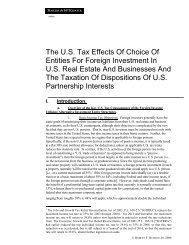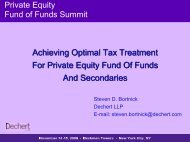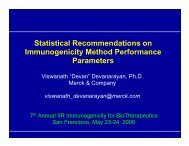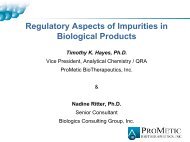Thorough QT Study: Design Features for Consideration - IIR
Thorough QT Study: Design Features for Consideration - IIR
Thorough QT Study: Design Features for Consideration - IIR
You also want an ePaper? Increase the reach of your titles
YUMPU automatically turns print PDFs into web optimized ePapers that Google loves.
Slide 1<br />
<strong>Thorough</strong> <strong>QT</strong> <strong>Study</strong>:<br />
<strong>Design</strong> <strong>Features</strong> <strong>for</strong> <strong>Consideration</strong><br />
Charles M. Beasley, Jr., M.D.<br />
Distinguished Lilly Scholar<br />
Chief Scientific Office, Global Product Safety<br />
Eli Lilly and Company
Slide 2<br />
Ventricular Repolarization: Difficulties in Biomaker<br />
Measurement and Analysis<br />
• “there are difficulties in the exact determination of the points<br />
which are to be used <strong>for</strong> the measurement of the <strong>QT</strong> interval<br />
in a given complex”<br />
• “there are difficulties when the actual <strong>QT</strong> duration is<br />
corrected <strong>for</strong> heart rate”<br />
Lepeschkin & Scuawicz (1952) Circulation 6: 378-388
Slide 3<br />
Ventricular Repolarization: Difficulties in Biomaker<br />
Measurement and Analysis (Continued)<br />
• The range of complex-to-complex variability in <strong>QT</strong><br />
measurement may be 25 msec.<br />
Malik & Camm (2001) Drug Safety 24:323-351<br />
BUT<br />
• The difference of interest between mean <strong>QT</strong>c values is as<br />
small as 5 msec.<br />
Malik (2001) J Cardiovasc Electrophysiol 12:411-420
Slide 4<br />
<strong>Features</strong> to Consider<br />
• Desired outcome<br />
• Homogeneous vs diverse subjects<br />
• Parallel vs Cross-over design<br />
• Number of replicate ECGs signal averaged<br />
• Method of correcting <strong>QT</strong> interval <strong>for</strong> heart rate<br />
• Which positive control<br />
• Complete blinding vs blinding of ECG readers<br />
• Can adequate exposure to test drug be achieved with a single dose or does the test drug<br />
require multiple administrations to achieve steady state<br />
• What value is compared between treatments<br />
• Time points of data acquisition<br />
• Method of protecting against inflated potential <strong>for</strong> false finding of drug effect inherent in<br />
multiple time point comparisons<br />
• Inclusion of pK assessments
Slide 5<br />
Hierarchy of Desired Outcomes<br />
• “Stages 0-4”<br />
‣ Difficult to conduct a study that will demonstrate a “Stage 0”<br />
outcome<br />
‣ Although “Stages 0-2” would meet ICH-E14 criteria as “negative<br />
(good outcome)” <strong>for</strong> a thorough <strong>QT</strong> study, a “Stage 2” outcome<br />
might result in adverse labeling<br />
‣ The closer to “Stage 0”, the better <strong>for</strong> the commercial<br />
opportunities <strong>for</strong> a drug intended <strong>for</strong> wide chronic use in non-life<br />
threatening condition<br />
Morganroth, et al. (2004) Am J Cardiol 93:1378-1383<br />
Beasley, et al. (2005) J Am Coll Cardiol 46:678-687
Slide 6<br />
“Stage 0” Outcome<br />
Difference Drug - Placebo<br />
Upper Bound<br />
1-sided 95% CI<br />
Point Estimate<br />
0<br />
5 10<br />
msec
Slide 7<br />
“Stage 1” Outcome<br />
Difference Drug - Placebo<br />
Upper Bound<br />
1-sided 95% CI<br />
Point Estimate<br />
0<br />
5 10<br />
msec
Slide 8<br />
“Stage 2” Outcome<br />
Difference Drug - Placebo<br />
Upper Bound<br />
1-sided 95% CI<br />
Point Estimate<br />
0<br />
5 10<br />
msec
Slide 9<br />
“Stage 3” Outcome<br />
Difference Drug - Placebo<br />
Upper Bound<br />
1-sided 95% CI<br />
Point Estimate<br />
0<br />
5 10<br />
msec
Slide 10<br />
“Stage 4” Outcome<br />
Difference Drug - Placebo<br />
Upper Bound<br />
1-sided 95% CI<br />
Point Estimate<br />
0<br />
5 10<br />
msec
Slide 11<br />
Homogeneous vs Diverse Subjects<br />
• It might be likely that the more homogeneous the subjects, the less<br />
INTERsubject variability<br />
‣ Genetic screening <strong>for</strong> long <strong>QT</strong> syndrome variants?<br />
‣ Use of only very healthy subjects?<br />
• If factors that contribute to INTERsubject variability also have a<br />
differential influence on responses across treatments, they will contribute<br />
to INTRAsubject variability<br />
• It might be likely that using subjects without factors believed to possibly<br />
influence <strong>QT</strong> length over time, the less INTRAsubject variability<br />
‣ Use of only males with less hormonal variability over time?<br />
• INTRAsubject variability is the primary determinate of the precision of the<br />
measured treatment difference
Slide 12<br />
Parallel vs Cross-over<br />
• More statistical power per subject with cross-over<br />
• Parallel can be run more quickly, requiring less time commitment<br />
from subjects but will require > [(# treatments) * (# subjects)] to<br />
achieve same power as cross-over with (# subjects)<br />
• Cross-over is most frequently used
Number of Replicate ECGs Signal Averaged to Yield an Average<br />
<strong>QT</strong> Value<br />
Slide 13<br />
•Beat-to-beat variability under optimal recording conditions is<br />
substantial<br />
‣ True variability<br />
‣ Measurement error<br />
• Signal average to strengthen the signal<br />
• How many replicates<br />
‣ 3 is common<br />
‣ Probably some slight increase in reduction of variability with 6-7<br />
‣ The more the better within a time frame where factors influencing <strong>QT</strong> are not<br />
changing but the increase in reduction of variability will be very small beyond 6-7
Slide 14<br />
Method of Correcting <strong>QT</strong> <strong>for</strong> Heart Rate<br />
• Historical population <strong>for</strong>mula<br />
• Experimental population <strong>for</strong>mula<br />
• Individual correction <strong>for</strong>mula<br />
‣ 30+ non-treatment values over range of heart rates<br />
‣ Heart rate range should cover heart rate expected with treatment<br />
• Model based<br />
‣ RR – is a covariate in a repeated measures model<br />
Dmitrienko & Smith (2002) Drug Inf J 36:269-279<br />
Dmitrienko & Smith (2003) Pharm Stat 2:175-190
Slide 15<br />
Which Positive Control<br />
• Produce a mean increase in <strong>QT</strong>c of 5-10 msec with tight<br />
INTERsubject variability<br />
• Moxifloxacin most commonly used<br />
• IV ibutilide (ultra low dose) can be individually titrated<br />
•Other
Slide 16<br />
Complete Blinding vs Blinding of ECG Readers<br />
• To blind subjects and drug administrators requires many<br />
placebos and/or double-dummy administrations and all treatment<br />
periods must be at equal length<br />
• Generally necessary to completely blind only test drug and<br />
placebo
Slide 17<br />
Can Adequate Exposure to Test Drug be Achieved with a Single<br />
Dose or Does Test Drug Require Multiple Administrations to<br />
Achieve Steady State<br />
• The single dose scenario applies when drug is to be used as<br />
single-dose PRN or is so well tolerated that a large multiple at<br />
intended maximum therapeutic dose can be administered with<br />
impunity<br />
• Impacts the recommended possible primary comparisons
Slide 18<br />
What Value is Compared Between Treatments<br />
• With single dose design, 3 possibilities<br />
• With multi-administration design, 2 possibilities may be more<br />
reasonable<br />
• Change from “baseline” (as opposed to absolute value on<br />
treatment) may not be necessary<br />
‣ “Single-delta” comparison may be adequate
Slide 19<br />
Single Dose <strong>Design</strong><br />
• Single-delta<br />
Drug<br />
Placebo<br />
Test Day<br />
Administer<br />
Administer<br />
Time<br />
<strong>QT</strong>c<br />
V 1<br />
<strong>QT</strong>c<br />
V 2<br />
V 1<br />
–V 2<br />
• Double-delta<br />
Drug<br />
Placebo<br />
Baseline Day<br />
<strong>QT</strong>c<br />
<strong>QT</strong>c<br />
V 3<br />
V 1<br />
Test Day<br />
Administer<br />
Administer<br />
<strong>QT</strong>c<br />
V 2<br />
(V 2<br />
–V 1<br />
) – (V 4<br />
–V 3<br />
)<br />
<strong>QT</strong>c<br />
Multiple baseline days may be averaged<br />
Time
Slide 20<br />
Single Dose <strong>Design</strong><br />
• Triple-delta<br />
Baseline Day<br />
Test Day<br />
Drug<br />
<strong>QT</strong>c<br />
<strong>QT</strong>c<br />
<strong>QT</strong>c<br />
<strong>QT</strong>c<br />
V 1<br />
V 2<br />
V 3<br />
Administer<br />
V 4<br />
((V 4<br />
-V 3<br />
) – (V 2<br />
-V 1<br />
)) – (V 8<br />
-V 7<br />
) – (V 6<br />
-V 5<br />
))<br />
Multiple baseline days may be averaged<br />
Placebo<br />
<strong>QT</strong>c<br />
<strong>QT</strong>c<br />
<strong>QT</strong>c<br />
<strong>QT</strong>c<br />
V 5 V 6<br />
V 7Administer V 8<br />
Time<br />
‣ Using V 3<br />
, V 4<br />
and V 7<br />
, V 8<br />
allow <strong>for</strong> an alternative double-delta method
Slide 21<br />
Multiple Administrations to Steady State <strong>Design</strong><br />
•Single-delta<br />
Drug<br />
Test Day<br />
<strong>QT</strong>c<br />
Placebo<br />
Administer Administer Administer V 1<br />
<strong>QT</strong>c<br />
V 1<br />
–V 2<br />
•Double-delta<br />
Administer Administer<br />
Time<br />
Administer V 2<br />
Drug<br />
Placebo<br />
Baseline Day<br />
Test Day<br />
<strong>QT</strong>c<br />
<strong>QT</strong>c<br />
V 1<br />
Administer Administer Administer V 2<br />
<strong>QT</strong>c<br />
<strong>QT</strong>c<br />
(V2-V1) – (V4-V3)<br />
Multiple baseline days<br />
may be averaged<br />
V 3<br />
Administer Administer Administer V 4<br />
Time<br />
‣Acquisition of <strong>QT</strong>c immediately be<strong>for</strong>e administration of test drug and placebo on day 1 of administration of each<br />
would allow <strong>for</strong> triple-delta or alternative double-delta but not personally recommended
Slide 22<br />
Time Points of Data Acquisition<br />
• Must reasonably account <strong>for</strong> individual variation in T max and<br />
possible hysteresis<br />
• The more time points, the greater potential <strong>for</strong> failing to<br />
demonstrate non-inferiority to placebo at a given time point due to<br />
the bias inherent in multiple comparisons<br />
• 3 time points around population T max and a trough (be<strong>for</strong>e a next<br />
administration) to account <strong>for</strong> metabolites may be reasonable
Slide 23<br />
Protection Against Inflated Potential <strong>for</strong> False Finding of Drug<br />
Effect in Multiple Comparisons<br />
• Inconsistent with ICH-E14 guidelines<br />
Beasley, et al. (2005) J Am Coll Cardiol 46:678-87<br />
Eaton, et al. (2006) Drug Inf J 40:267-271
Slide 24<br />
Inclusion of pK Assessments<br />
• With each ECG collection<br />
• Allows <strong>for</strong> pK-pD relationship estimation<br />
‣ May offer some protection against drawing definitive conclusions<br />
from a spurious finding at a given time point among multiple time point<br />
comparisons
Slide 25
















